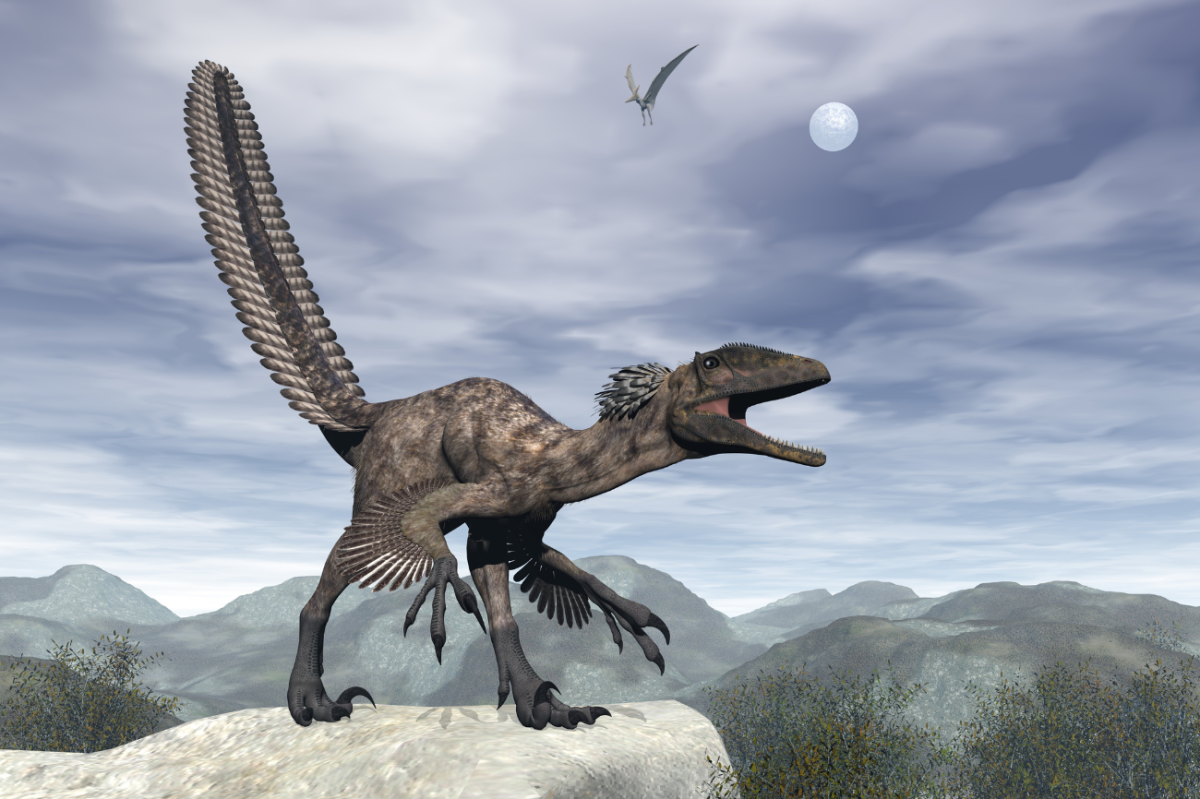The Real-Life Inspiration Behind the ‘Jurassic Park’ Velociraptors
Posted on Categories Discover Magazine

Apart from Tyrannosaurus Rex, no other group of dinosaurs has captured popular imagination like the Dromaeosaurs. Fast-moving and potentially fast-thinking, these dinosaurs grew feathers and often appeared more birdlike than many of their contemporaries.
Nicknamed the “raptors,” perhaps the most well-known Dromaeosaur is the Velociraptor.
How Big Were Velociraptors?
Much of this dinosaur’s fame comes thanks to the Jurassic Park movies, which featured large beasts referred to as Velociraptors. In reality, however, they were much smaller — somewhere between a chicken and a fox in size.
The film-famous version was instead based on another Dromaeosaur, called Deinonychus antirrhopus.
“Honestly, Velociraptors would be kickable,” says Ashley Poust, a paleontologist at the San Diego Natural History Museum who studies Dromaeosaurs. “But Deinonychus would be terrifying — that would be like running into a tiger.”
Read More: How Do Scientists Reconstruct What Dinosaurs Looked Like?
Who Were the Dromaeosaurs?
Dromaeosaurs, a term that translates to “running lizards,” were theropods that lived in the Cretaceous Period, and possibly the Jurassic. Velociraptors were among the first to be discovered, in a 1920s expedition in the Gobi Desert of Mongolia.
“It was really the first time we saw what a Dromaeosaur really was,” Poust says. The oldest of these specimens date to about 75 million years ago.
Other major discoveries in Asia included even smaller species, like the Microraptors, including one described by Poust in 2020 called the Wulong bohaiensis. It dates to 120 million years ago or later, and is likely one of the most primitive of the whole group.
But it wasn’t until the 1960s that a group of other discoveries made in the U.S. and Soviet Union really began to fill out the rest of the family tree.
Read more: Did Humans and Dinosaurs Ever Live Together?
Raptor Claws
In Montana, researchers discovered remains of a foot and the infamous curved claw of the Deinonychus, which feature so prominently in the Jurassic Park franchise. The dinosaurs held these claws, thought to have been present in all Dromaeosaurs, retracted and off the ground — likely so their sharpness wouldn’t become dull by walking or running.
Despite what the movies say, scientists don’t always agree about the use of this sharp claw.
It may have been used for slashing or pinning down prey. Still others believe it may have been used for climbing up larger prey to bite their necks, Poust says.
The fossils were particularly surprising because it seemed clear that Deinonychus was a faster moving predator that relied on speed — rather than “lumbering, pathetic failures,” Poust says. “[The discovery] really started what some people call ‘The Dinosaur Renaissance.’”
Meanwhile, in parts of the Soviet Union, scientists found remains of species like Kansaignathus sogdianus, which a recent study published in Cretaceous Research has revealed is likely the oldest member of the Velociraptor group.
Read more: Scientists Find Footprints Older Than the Dinosaurs
Deinonychus Prowled in Packs
The whole notion that these creatures may have hunted in packs comes from just a few discoveries.
Many fossilized remains of Tenontosaurus, a larger herbivorous dinosaur, have been found with embedded Deinonychus teeth. One Tenontosaurus fossil even contained the teeth of several individuals, leading some researchers to the conclusion that Deinonychus may have hunted in packs.
The trouble with this idea, Poust says, is that it’s unclear whether all these Deinonychus were eating this Tenontosaurus at the same time. Instead, the body could have been scavenged by several individuals.
Yet other researchers have pointed out other Tenontosaurus remains found in association with Deinonychus.
An adult Tenontosaurus likely would have weighed five times more than an adult Deinonychus. Therefore, some researchers believe that the smaller predators would have had to work together in order to take down such large prey.
Read More: 5 Massive Dinosaur Fossils and Where They Were Found
Sinornithosaurus: Feathered Lizards
The name “raptor” isn’t the only thing that members of this group share with birds; some fossils, like those from Sinornithosaurus, have actually been found with preserved feathers.
“That was cool because [Sinornithosaurus] was one of the earliest members of this group, both in the family tree and in time,” Poust says. Other Dromaeosaurs have dots on their bones where feathers likely would have attached.
It’s unclear, however, whether any Dromaeosaurs could fly or glide. It’s possible that some of the smaller, earlier members — like Microraptors — could fly. Regardless, Poust says they might have still used their feathers for mobility when running straight up walls or trees, for example.
Due to their larger sizes, it’s unlikely that later Dromaeosaurs like Deinonychus and Utahraptors could fly. “As soon as these animals start getting too large, they seem to abandon this skill,” Poust says. This is also true of modern-day ostriches, who lost the ability to fly over evolutionary time.
Larger Dromaeosaurs still retained feathers, though. Some, whose feathers stuck out from their back legs, for example, might have used them as displays.
Read more: Did All Dinosaurs Have Feathers?
Dromaeosaur Extinction
Though some went extinct earlier, Dromaeosaurs as a group persisted for quite a long time. Some members of the group lived up until the Chicxulub asteroid struck Earth, about 66 million years ago.
“The group may have witnessed the rise of birds, existed for 100 million years, and succeeded for longer than the duration of the age of mammals,” Poust says.
While likely not a direct ancestor to modern birds, the whole group of Dromaeosaurs is still closely related to them and other species in that evolutionary trajectory, like Archaeopteryx.
“They’re a pretty successful group,” Poust says.
Read more: The End of Dinosaurs: The End-Cretaceous Mass Extinction